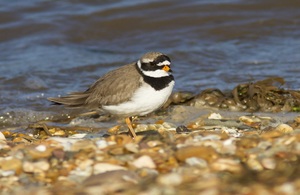125,000 seabirds to benefit from expansion of protected site
Expansion of Solway Firth site boosts England’s network of Marine Protected Areas

Red-throated diver and ringed plover to join protected species at Solway Firth.
The UK government has today boosted the country’s ‘Blue Belt’, England’s network of Marine Protected Areas (MPAs), by announcing the expansion of the Solway Firth protected site.
Over 125,000 seabirds will benefit from the expansion of this site, with red-throated diver and ringed plover joining the extensive list of species already protected. This will also encourage population growths for important species such as wintering divers and gulls.
The protected area in Solway Firth sits in both English and Scottish waters and today will be expanded in total by 92,070 hectares, becoming an impressive 135,750 hectares in size. The devolved administration in Scotland also announced a similar expansion in its waters today, as well as several other MPAs.
The expansion of the Solway Firth site follows work undertaken by Nature Scot and Natural England to provide scientific advice and conduct public consultation on the introduction of further protections.
It will provide clarity on where boundaries of important foraging areas for protected seabird species are and offers the opportunity to adopt additional management measures if required, which may include byelaws to manage commercial fishing or the zoning of recreational activities such as water sports.
The UK government is committed to protecting and enhancing our marine environment; recently adding to our MPA network for England, expanding an internationally significant protected site on the Isles of Scilly and launching a call for evidence on proposals for managing five of England’s Marine Protected Areas including the Canyons, a deep-sea habitat which harbours cold water corals, and Dogger Bank, the largest shallow sandbank in British waters.
Environment Secretary George Eustice also recently announced his intention to pilot Highly Protected Marine Areas where all extractive and destructive activities would be removed, following publication of the independent Benyon Review into HPMAs.
Environment Minister Rebecca Pow said:
The UK seabird population is of global importance with the UK holding more than a quarter of Europe’s breeding seabirds. This addition to England’s vital MPA network is a significant step forward in our ongoing commitment to protect and improve the resilience of our marine environment and its precious wildlife.
Together with the development of our Seabird Conservation Strategy, we will help the coastal environment to recover and thrive for future generations to enjoy.
Marian Spain, Natural England Chief Executive, said:
The new protections at Solway Firth, based on advice from the UK’s world-leading scientists will create more space for nature to recover and signify a significant step forward in enhancing protections for a range of globally important sea and shorebirds.
We will continue to work with Defra as they develop their Seabird Conservation Strategy to understand the challenges that seabird populations currently face and consider what further measures are needed to help their recovery.
Working closely with stakeholders, Defra is developing a landmark Seabird Conservation Strategy, which will look at the range of pressures faced by different seabird species in order to take additional steps to build on today’s achievement and further support our iconic seabird populations.